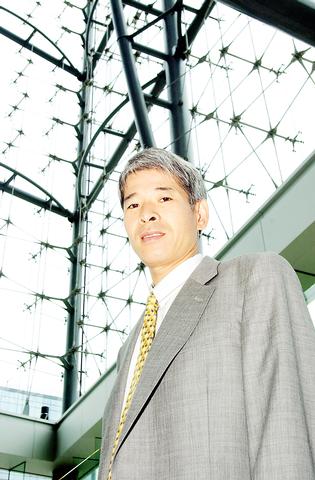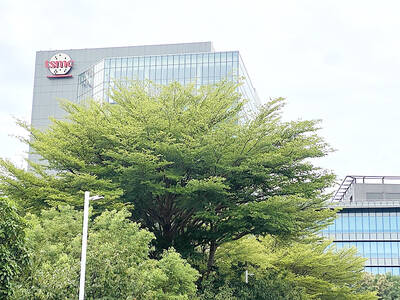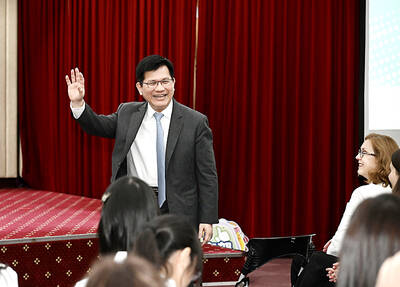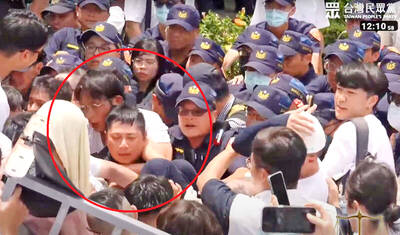Taipei Times: Premier Image Technology Corp (
Cliff Liu (劉燈桂): Last year, digital cameras made up around 32 percent (of sales) and compact cameras were 55 percent and we have some other products, around 2 or 3 percent. The digital camera this year, we believe, will be over 50 percent (of sales) and we still see the trend in the digital cameras continuing.
Last year, a lot of people said our digital camera sales this year would grow 15 percent, and if they were very aggressive, maybe 20 to 25 percent growth. Up to the first three months of this year, people have become more optimistic and revised up their growth. I am also more optimistic. I believe we will attain a growth rate of 25 percent or 30 percent in digital camera sales.

PHOTO: CHIANG YING-YING, TAIPEI TIMES
You can see the results from our first quarter calculations, over 30 percent growth over last year and in April, we had 70 percent growth over last year. We still see digital cameras becoming more popular in the market.
TT: Of the cameras you make, are they contract manufactured for other customers or are any marketed under the Premier brand name?
Liu: Actually, we do very good business on ODM, original design manufacturing (design and manufacture for customers). About 57 percent of our sales are ODM and around 20 percent are sold on an OEM (original equipment manufacturer) basis. Our own brand makes up over 20 percent of sales.
Actually, Premier strongly promotes Premier brand products in a lot of developing markets -- Taiwan, China, India, the Middle East, Russia and Latin America -- because in developing countries, most people buy a little bit more in the lower end (of the market) and the branded products concentrate much more on developed markets -- Japan, the United States, Europe -- and in those areas we will not promote any Premier brand at all.
But in China we are doing very well. In China we have set up over 29 branch offices and we have over 400 exclusive contracts to sell cameras in department stores in major cities and we have over 4,000 agents all over China selling Premier cameras. As we all saw, last year the Chinese computer market grew very quickly and a lot of people, including Taiwanese manufacturers and Chinese distributors, also bought digital cameras from us. So, we promoted our digital cameras mostly in Taiwan ,China and other developing countries. You can easily find Premier cameras in Taiwan's department stores and photo shops.
TT: What kinds of returns are you seeing in China? How much of your sales will China make up this year?
Liu: I cannot tell you that. But one thing I want to emphasize is that it is very easy to sell cameras in China -- many people want to buy cameras. The most difficult thing is collecting the money.
In China, most distributors look like they are willing to buy -- but they are not willing to pay. We have over 4,000 sales agents in China and a lot of sales managers from Taiwan, who will travel throughout China to determine if the distributor will pay. They look to see if the payments are on track or not. If it looks like they (the distributors) are unwilling to pay, without any other considerations we have to bring all those cameras back to our branch office. So maintaining control over accounts receivable is very important in China.
We chose the 4,000 agents we have very carefully -- they have good credibility. Because in China it is very easy to find people to sell your cameras, but it is not easy to gather the money afterwards.
In China, we are legally authorized by the Chinese government to sell 50 percent of the cameras we produce there. Premier is the only company in China to set up the complete distribution network: branch offices, exclusive contracts and agents selling Premier cameras. We are really a China player -- we have 5,000 workers assembling over a million pieces in China and 30 percent of our raw materials are purchased in China.
So, after factoring in the lower labor cost and the cheaper raw materials, we also sell into the market I think from our financial report of 2000, we had about 9 percent sales contribution from the China market and our profit was quite good.
TT: What is your cost savings, China versus Taiwan?
Liu: If you just compare to Taiwan and China, there is quite a big difference in price. The comparison is not easy to make. If you purely calculate the worker level costs, that is very big. I think this issue is quite sensitive so I don't really want to put a figure on that. The cost is really different.
TT: How long have you been in China?
Liu: We have been there for 10 years. Please note, we don't just have our camera assembly plants in China, we have also have moved satellite plants [plants that make camera components and other supporting materials] there as well. We also have assembly factories in Shenzhen, Guangzhou -- we also have satellite factories including plastic injection, metal stamping, glass grinding, painting and assembly. In total we have 9,000 workers. How can Taiwan supply enough -- at that cost level -- that is a big issue.
But in Taiwan we have hired more value-added engineers. We will keep our roots in Taiwan. This new building we just completed is evidence. The old building was so crowded, so small, but this new building is 15,000 ping. We will keep it all for our own purposes and we will recruit more engineers. We also just purchased a new R&D center in Hsinchu.
Between Hsinchu and Taipei, I think there are more than 550 (employees) but over half are R&D engineers and we are going to recruit more engineers. So even though our production is in China, we keep all of our headquarters, financial control, sales, QC, R&D and high-end production in Taiwan -- the cameras over 1 Megapixel, 3 Mega 300, 4 Mega 400 and next year we are going to produce a 5 Megapixel camera.
We do all of our value-added jobs in Taiwan, but all lower cost, lower value-added production we will move to China.
I think I should point out that Premier owns a lot of its own technology -- our own optical technology. In the past two decades, we used our optical technology to make compact cameras. In the past five years, we used the optical core technology to build digital cameras, and now we are using the optical technology to build the LCD projector. Because the projector uses a lot of optical components. This will be designed in-house.
Originally, our name was Premier Camera, but we wanted to emphasize that we don't just make cameras so we changed our name to Premier Image. We will make products applied to the image but made with optics -- this is very clear, it is the company's long term goal.
TT: How much are you putting into R&D every year?
Liu: About 3 percent [of revenue]. Last year, sales were about NT$11.3 billion, around 2.5 percent or 3 percent.
TT: Many industry experts and academics have argued that most Taiwanese companies only put in about 3 percent and that's just not enough. What do you say?
Liu: It depends on the industry. For us, I think it is okay. Our advantage is we cooperate with Japan and gain a lot of technology transfer. That's much cheaper than adding more R&D. One very simple example -- three or four years ago, we had one camera that had a shutter speed of 1/10,000 second and we wanted to break that speed. If we had to spend the money to surpass that speed, it would have been a lot, a lot, a lot of money. But because our customer transferred the technology, it was much cheaper. This is a very good way of doing business for us.
TT: Didn't you have to pay for the technology, a licensing fee or whatnot?
Liu: No, nothing like that because we did a technology transfer. I think 3 percent is considered in our industry just fine.
TT: How much of your total production this year will come from Taiwan?
Liu: I think in Taiwan it is around 10 percent, 10 something percent.
TT: The Japanese are building manufacturing plants in China, do you see that as a threat to your own earnings?
Liu: For us it isn't. For other manufacturers it might be a threat, especially to some contract manu-facturers or for OEM manufacturers. Actually, a number of our customers have been manufacturing in China as long as we have, but they still buy some cameras from us because we emphasize the ODM -- we design a lot of products for them.
No one -- no single company no matter how big -- can do every-thing in house. Even Fuji, which is a big company, they have to buy a lot of cameras from us because they have to consider what their value-added [ability] is. They may do the high end, and we do the middle level for them.
We have a lot of projects we co-design, co-develop with them. If we didn't, the burden would be too heavy for them. For example, one product we produce for Minolta, they have their own factory in China. Why do they buy from us? [Because we do the design.] That's the reason why the ODM margins are much higher and more value-added.
Another issue -- I don't think if you set up two factories, a Tai-wanese factory in China and a Japanese one in the same location, I don't think the efficiency would be the same. The Taiwanese factory would be more efficient.
We have a lot of know how, we know how to produce things at lower costs, much more efficiently.
My personal observation is that this is because if you look at Japan six or seven years ago -- before the Asian economic crisis -- Japan had a very serious psychological fear of China. Therefore they invested most of their money in Southeast Asia, Indonesia, Malaysia and a lot less in China. But after the economic crisis, they couldn't recoup their investment from those places. Now, China is becoming more and more open and the Japanese begin to fear China less and less, and now they invest there -- China's government has been more stable, they have joined the WTO.
I see a lot of opportunity in China but not in Japan -- and our business is mostly with Japanese companies. The Japanese are experiencing an economic downturn because if they have 10 factories, each operating at 50 percent capacity, they cannot close a single one. In Taiwan, I would close five factories and operate five at 100 percent capacity -- but the Japanese have the lifetime employment so they cannot lay off workers. This is a very serious problem.
So they have been very late to move to China, and their small- and medium-sized enterprises have not moved -- this is a big problem. They have focused too much on building infrastructure and their pace of real change has been far too slow.

FIREPOWER: On top of the torpedoes, the military would procure Kestrel II anti-tank weapons systems to replace aging license-produced M72 LAW launchers Taiwan is to receive US-made Mark 48 torpedoes and training simulators over the next three years, following delays that hampered the navy’s operational readiness, the Ministry of National Defense’s latest budget proposal showed. The navy next year would acquire four training simulator systems for the torpedoes and take receipt of 14 torpedoes in 2027 and 10 torpedoes in 2028, the ministry said in its budget for the next fiscal year. The torpedoes would almost certainly be utilized in the navy’s two upgraded Chien Lung-class submarines and the indigenously developed Hai Kun, should the attack sub successfully reach operational status. US President Donald Trump

Taiwan Semiconductor Manufacturing Co (TSMC, 台積電) is expected to start construction of its 1.4-nanometer chip manufacturing facilities at the Central Taiwan Science Park (CTSP, 中部科學園區) as early as October, the Chinese-language Liberty Times (the Taipei Times’ sister newspaper) reported yesterday, citing the park administration. TSMC acquired land for the second phase of the park’s expansion in Taichung in June. Large cement, construction and facility engineering companies in central Taiwan have reportedly been receiving bids for TSMC-related projects, the report said. Supply-chain firms estimated that the business opportunities for engineering, equipment and materials supply, and back-end packaging and testing could reach as high as

ALL QUIET: The Philippine foreign secretary told senators she would not respond to questions about whether Lin Chia-lung was in the country The Ministry of Foreign Affairs on Wednesday confirmed that a business delegation is visiting the Philippines, but declined to say whether Minister of Foreign Affairs Lin Chia-lung (林佳龍) is part of the group, as Philippine lawmakers raised questions over Lin’s reported visit. The group is being led by Deputy Minister of Agriculture Huang Chao-chin (黃昭欽), Chinese International Economic Cooperation Association (CIECA) chairman Joseph Lyu (呂桔誠) and US-Taiwan Business Council (USTBC) vice president Lotta Danielsson, the ministry said in a statement. However, sources speaking on condition of anonymity said that Lin is leading the delegation of 70 people. Filinvest New Clark City Innovation Park

TPP RALLY: The clashes occurred near the Chiang Kai-shek Memorial Hall on Saturday at a rally to mark the anniversary of a raid on former TPP chairman Ko Wen-je People who clashed with police at a Taiwan People’s Party (TPP) rally in Taipei on Saturday would be referred to prosecutors for investigation, said the Ministry of the Interior, which oversees the National Police Agency. Taipei police had collected evidence of obstruction of public officials and coercion by “disorderly” demonstrators, as well as contraventions of the Assembly and Parade Act (集會遊行法), the ministry said in a statement on Sunday. It added that amid the “severe pushing and jostling” by some demonstrators, eight police officers were injured, including one who was sent to hospital after losing consciousness, allegedly due to heat stroke. The Taipei